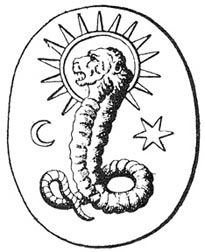Gnosis
Gnosis[edit | edit source]
Gnosis is a term of Greek origin that signifies "knowledge" or "insight." In the context of Gnosticism, it refers to the spiritual knowledge or insight that is essential for salvation. Gnosis is not merely intellectual knowledge but a deeper, mystical understanding of the divine.
Historical Context[edit | edit source]
Gnosticism emerged in the early centuries of the Common Era, during a time of religious and philosophical diversity in the Roman Empire. It is characterized by a dualistic worldview, where the material world is seen as flawed or evil, and the spiritual realm is considered pure and good. Gnostics believed that salvation was achieved through gnosis, which allowed individuals to transcend the material world and return to the divine source.
Key Concepts[edit | edit source]
Dualism[edit | edit source]
Gnosticism is known for its dualistic view of the universe. This dualism is often expressed as a conflict between light and darkness, spirit and matter, or good and evil. The material world is typically seen as the creation of a lesser deity, often referred to as the Demiurge, who is distinct from the true, transcendent God.
The Divine Spark[edit | edit source]
Gnostics believe that within each human being resides a divine spark, a fragment of the divine essence. This spark is trapped within the material body and can only be liberated through gnosis. The acquisition of gnosis allows the individual to recognize their true divine nature and return to the divine realm.
The Role of the Savior[edit | edit source]
In Gnostic belief, a savior figure, often identified with Jesus Christ, plays a crucial role in imparting gnosis to humanity. This savior is seen as a revealer of divine knowledge, guiding souls back to the divine source.
Gnostic Texts[edit | edit source]
Gnostic teachings are preserved in a variety of texts, many of which were discovered in the Nag Hammadi library in 1945. These texts include the Gospel of Thomas, the Gospel of Philip, and the Apocryphon of John. These writings offer insights into the diverse beliefs and practices of Gnostic groups.
The Lion-Faced Deity[edit | edit source]
The image of the lion-faced deity, often associated with Gnostic symbolism, represents the complex and esoteric nature of Gnostic cosmology. This deity is sometimes linked to the figure of Yaldabaoth, a representation of the Demiurge, or to other archonic powers that govern the material world.
Influence and Legacy[edit | edit source]
Gnosticism has had a lasting impact on various religious and philosophical traditions. Elements of Gnostic thought can be found in Christian mysticism, Kabbalah, and modern esotericism. The emphasis on personal spiritual knowledge continues to resonate with contemporary spiritual seekers.
Related Pages[edit | edit source]
Search WikiMD
Ad.Tired of being Overweight? Try W8MD's physician weight loss program.
Semaglutide (Ozempic / Wegovy and Tirzepatide (Mounjaro / Zepbound) available.
Advertise on WikiMD
|
WikiMD's Wellness Encyclopedia |
| Let Food Be Thy Medicine Medicine Thy Food - Hippocrates |
Translate this page: - East Asian
中文,
日本,
한국어,
South Asian
हिन्दी,
தமிழ்,
తెలుగు,
Urdu,
ಕನ್ನಡ,
Southeast Asian
Indonesian,
Vietnamese,
Thai,
မြန်မာဘာသာ,
বাংলা
European
español,
Deutsch,
français,
Greek,
português do Brasil,
polski,
română,
русский,
Nederlands,
norsk,
svenska,
suomi,
Italian
Middle Eastern & African
عربى,
Turkish,
Persian,
Hebrew,
Afrikaans,
isiZulu,
Kiswahili,
Other
Bulgarian,
Hungarian,
Czech,
Swedish,
മലയാളം,
मराठी,
ਪੰਜਾਬੀ,
ગુજરાતી,
Portuguese,
Ukrainian
Medical Disclaimer: WikiMD is not a substitute for professional medical advice. The information on WikiMD is provided as an information resource only, may be incorrect, outdated or misleading, and is not to be used or relied on for any diagnostic or treatment purposes. Please consult your health care provider before making any healthcare decisions or for guidance about a specific medical condition. WikiMD expressly disclaims responsibility, and shall have no liability, for any damages, loss, injury, or liability whatsoever suffered as a result of your reliance on the information contained in this site. By visiting this site you agree to the foregoing terms and conditions, which may from time to time be changed or supplemented by WikiMD. If you do not agree to the foregoing terms and conditions, you should not enter or use this site. See full disclaimer.
Credits:Most images are courtesy of Wikimedia commons, and templates, categories Wikipedia, licensed under CC BY SA or similar.
Contributors: Prab R. Tumpati, MD

